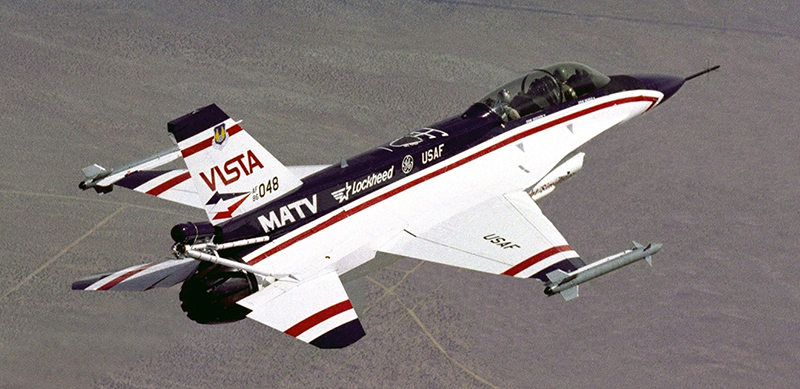Born as an in-flight simulator, the F-16 VISTA (Variable Stability In-Flight Simulator Test Aircraft) had the task to simulate the performance of the newest fighter jets.
The F-16 VISTA was built around a standard production F-16D airframe and introduced many features which a classic F-16 didn’t have.
In fact the airframe included a larger capacity hydraulic pump, a programmable center stick controlled by the digital computer installed in the front cockpit and a custom designed variable stability system which allowed the VISTA’s very different flight envelope. The distinctive characteristic of the VISTA was that controls to manage the flight envelope were put in the back cockpit and, only after successful access they could be transferred to the front seater: this particular system set-up enabled return control to the backseater in case the front pilot faced a dangerous situation.
After VISTA made its maiden flight in April 1992 the program funds for the next two years were withdrawn.
Luckily the VISTA was resurrected by the General Electric that had the need for a program to demonstrate how the vectoring thrust could improve the F-16’s maneuverability.
The Multi-Axis Thrust Vectoring (MATV) required major modifications of the VISTA to be uninstalled, and the addition of a spin chute along with the characteristic vectoring engine nozzle. Even if a Eurofighter Typhoon pilot explained to The Aviationist that thrust vectoring (TV) is not essential in an air-to-air scenario, it could give the pilot the advantage to point the nose against an enemy fighter controlling its aircraft beyond the stall, in a so-called “post stall” regime.
At that time, this concept was more or less theory, and the task of the F-16 VISTA during the MATV program was to demonstrate the effectiveness of the thrust-vectoring during some post stall maneuvers as well as the advantage it could give to the fighter during Within Visual Range (WVR) engagements.
The results were that during the MATV program, the F-16 VISTA was able to perform the “cobra” maneuver and proved itself extremely capable in 1 vs 1 and also in 1 vs 2 WVR engagements against two normal Vipers.
When the MATV program ended, the original VISTA features were reinstalled on this one-of-a-kind aircraft that was then delivered to the Test Pilots School at Edwards Air Force Base where it is still flying today.
Some features of this F-16 were eventually embedded in the F-35.
At Edwards, it was finally able to serve as an in-flight simulator, demonstrating to be perfect in training pilots in particular handlings.
Thanks to its centre and the side stick installed in the front cockpit the F-16 VISTA can be re-configured after the take off to fly like a delta wings aircraft, like a canards one or like a large cargo airplane.













